Cranberry sourdough bread is a rustic, hearty loaf terrific for toasting or turkey sandwiches! We added walnuts for extra flavour and texture.
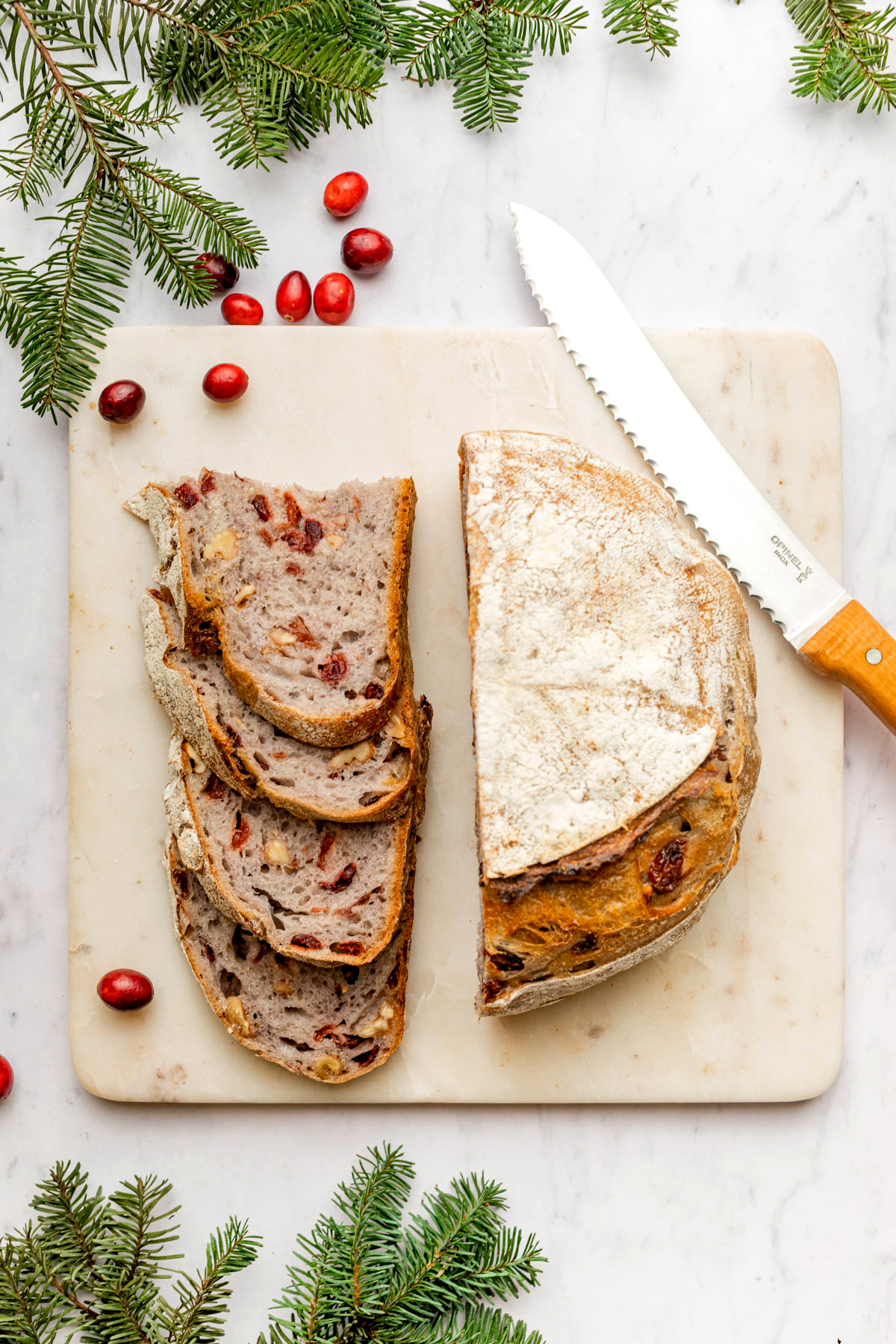
photography by Sophie MacKenzie
It’s no secret that we are passionate about sourdough. There’s something so meditative about the process, and rewarding about lifting the lid from a Dutch oven to reveal a beautiful loaf inside.
We want to show you how to make cranberry sourdough bread using sourdough levain. A levain is basically a small amount of active sourdough starter you make the night before using cold starter from the fridge. We love baking with levain because you can make what you need, in any amount you want, without having to remember to feed your starter every day or two.
Baking sourdough bread is not a fast process (especially if using levain which adds an extra night). We promise however, most of the time is spent hands off, and the result is totally worth it!
If you don’t want to make levain, you can use active bubbly starter (if you are new to sourdough, check out this post called How To Make Sourdough Starter From Scratch). We use walnuts for this loaf because they’re such a compliment to cranberries, but you can switch in any nuts or seeds you like. We’ve got more tips and notes below, as well as links to tutorials on our site if you have any questions. Happy baking!
[feast_advanced_jump_to]Ingredients

- Levain — Sourdough levain is essentially a small amount of active sourdough starter you make the night before using cold sourdough starter from the fridge. For more information, we have a post called How To Make Sourdough Levain For Sourdough Bread.
- Flour — We used all-purpose white flour for this recipe.
- Salt — Fine sea salt is always a great option, however, regular iodized table salt also works.
- Dried Cranberries — We used dried sweetened cranberries, however, feel free to use unsweetened.
- Walnuts — Whole raw walnuts are great, however, feel free to toast them before hand for extra flavour. Toasted nuts must be cooled before adding them to the dough.
Use the JUMP TO RECIPE button at the top, or scroll to the bottom of the post to see the printable recipe card with full ingredient measurements and complete instructions.
Method
Day 1: Make The Leavin
Make the levain in the evening before bed and let it activate in a warm, draft-free spot overnight. For full instructions on how to make sourdough levain, visit this post called How To Make Sourdough Levain For Sourdough Bread.
Day 2: Make & Shape The Dough

Combine the water and flour in a mixing bowl. 
Add the levain and mix with your hands. Cover and rest.
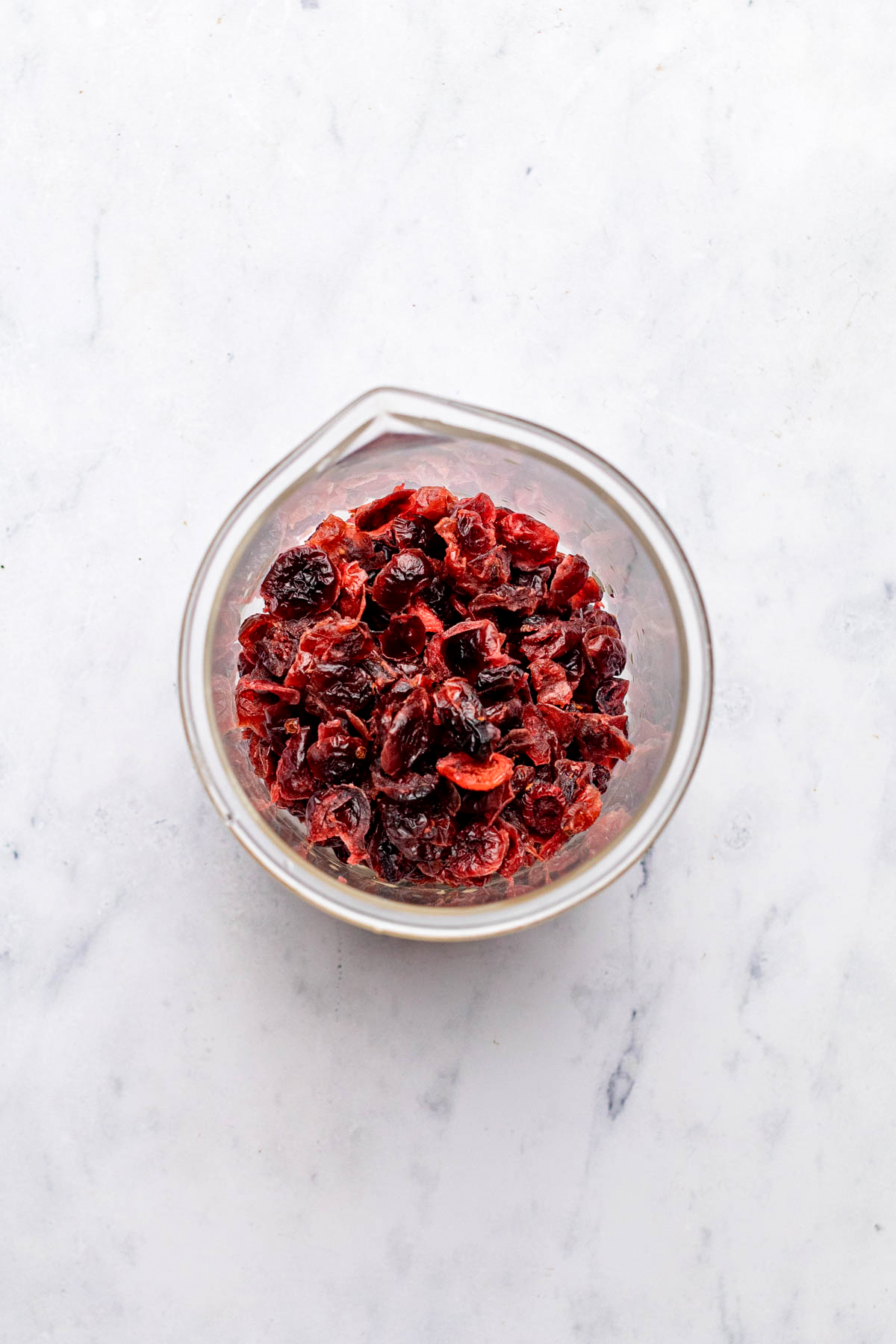
Soak the cranberries and walnuts. 
Water should be 1 inch above for a good soak.
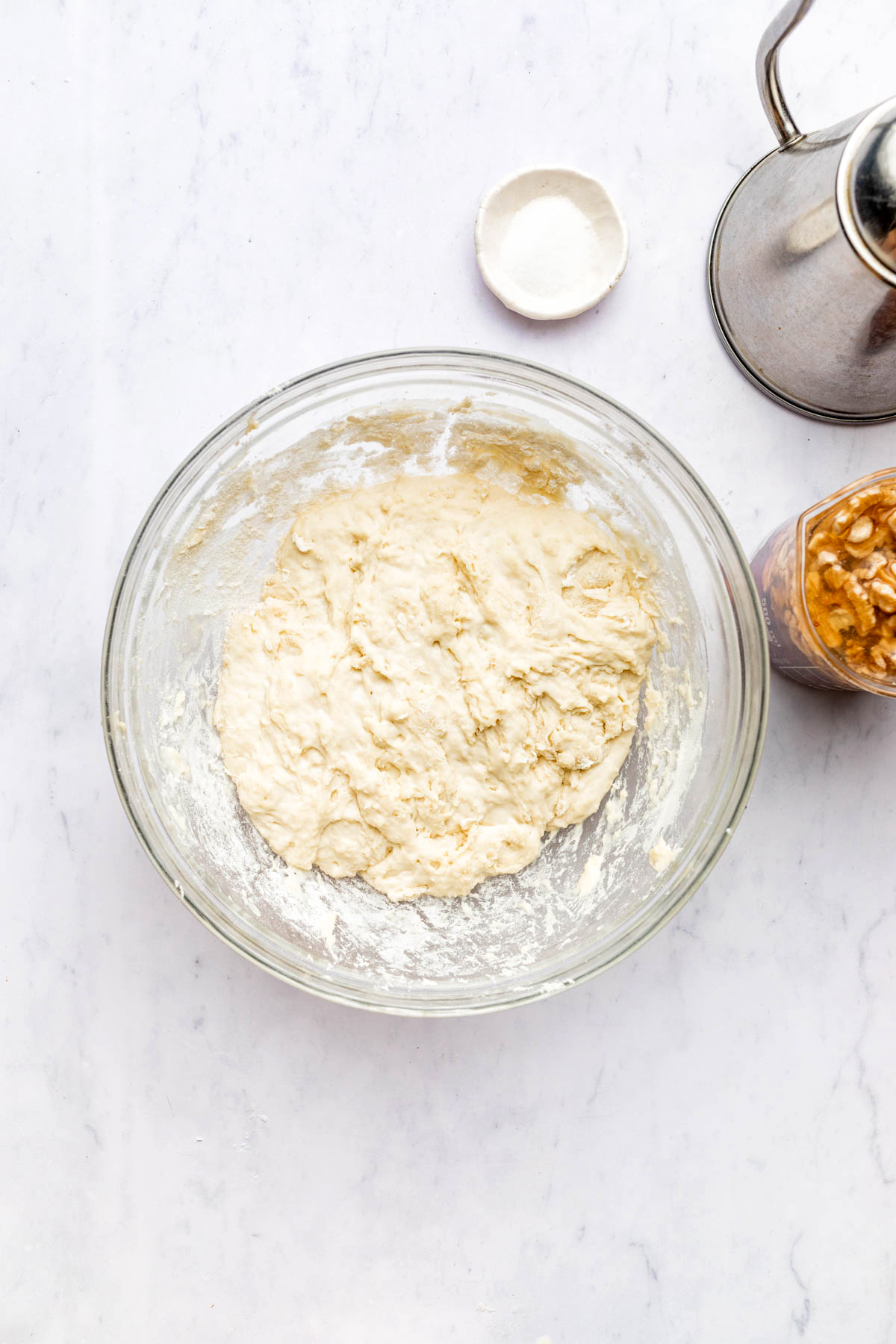
Sprinkle some salt over the rested dough. 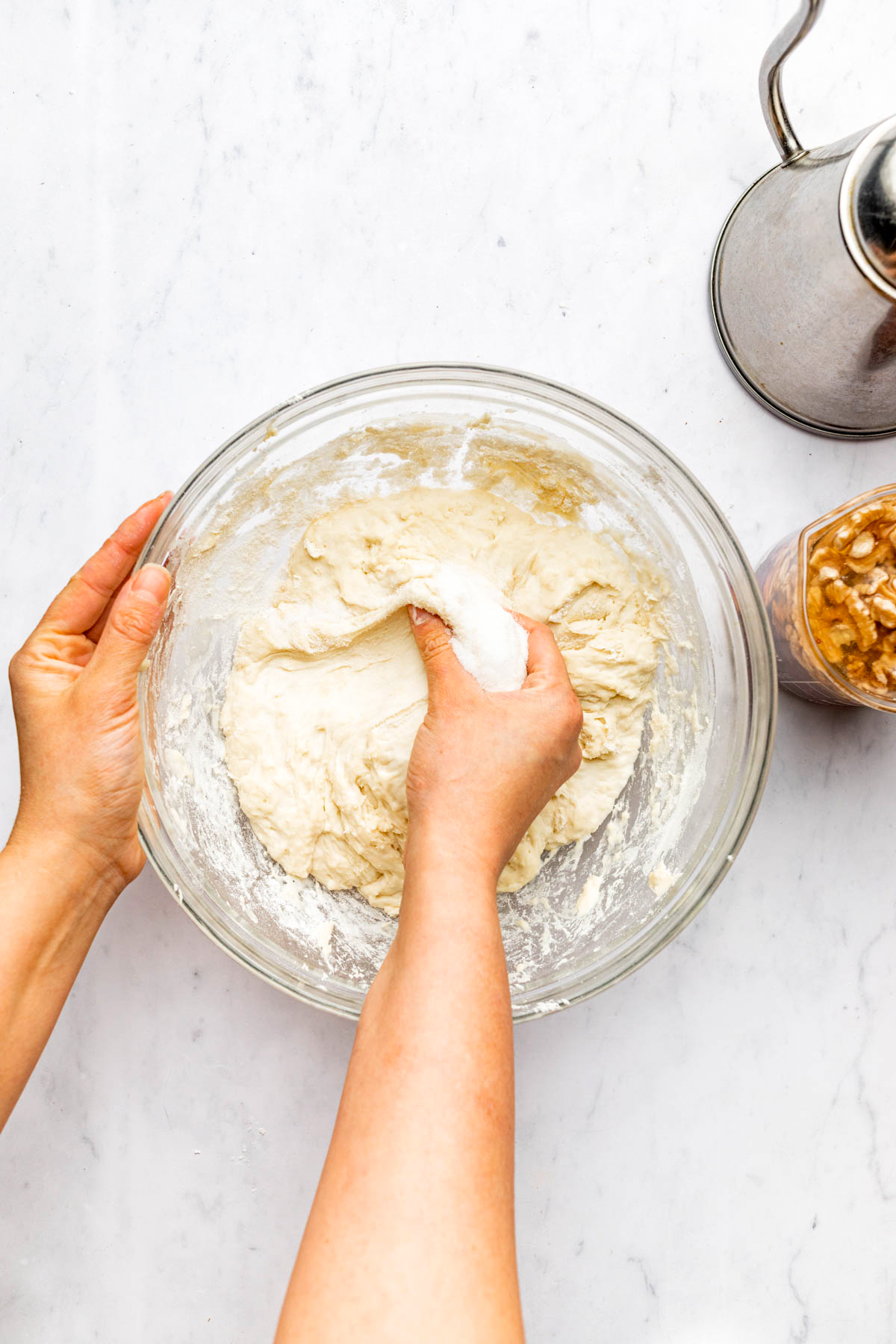
Use your hands to mix it in gradually until it’s gone.

Drain the cranberries and walnuts and add them to the dough. 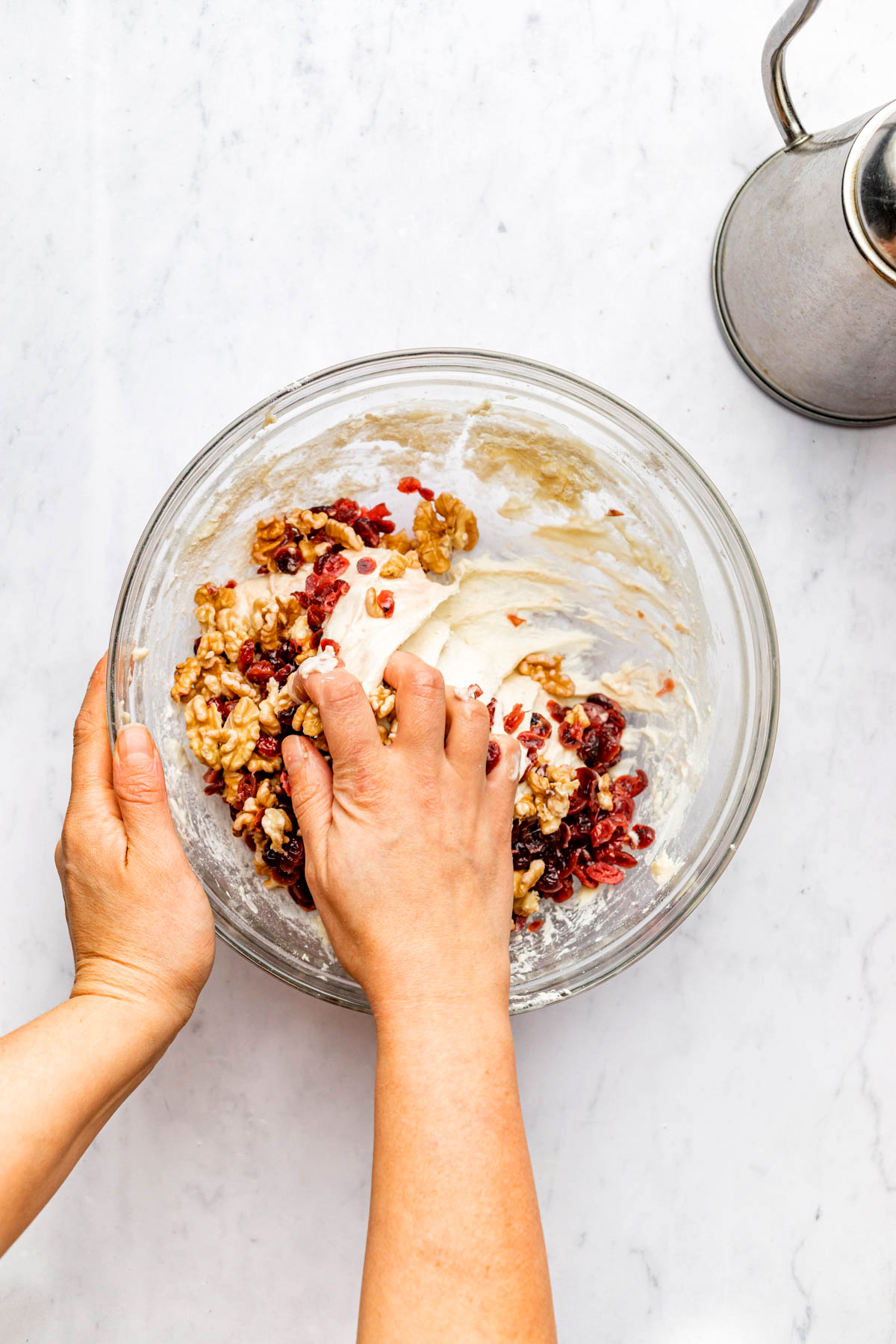
Use your hands to mix them in.
TOP TIP
Slice the cranberries and walnuts into smaller pieces before adding them to the dough if you want.
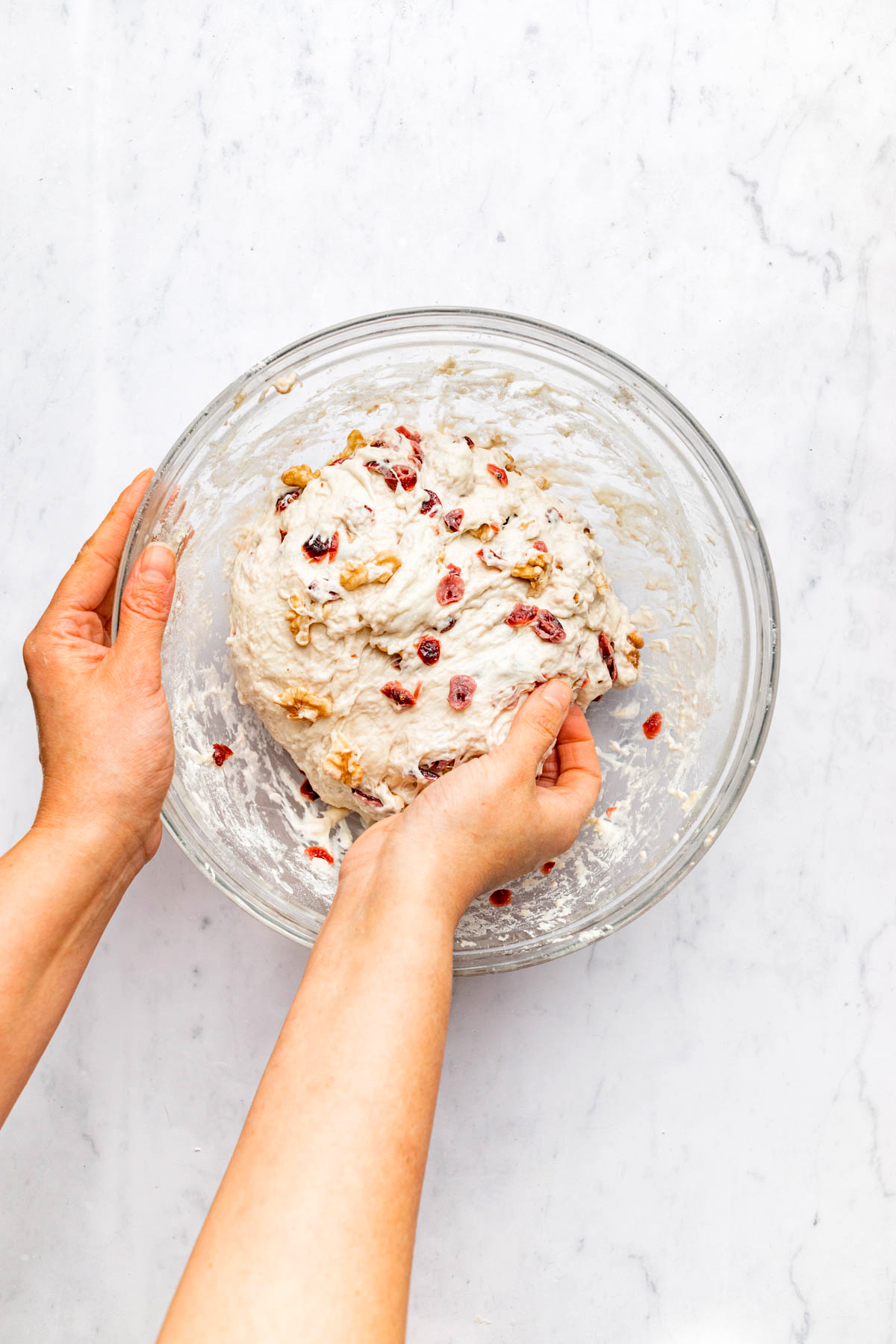
Do six series of stretch and folds, one every 30 minutes. 
Cover the bowl between each stretch and fold.
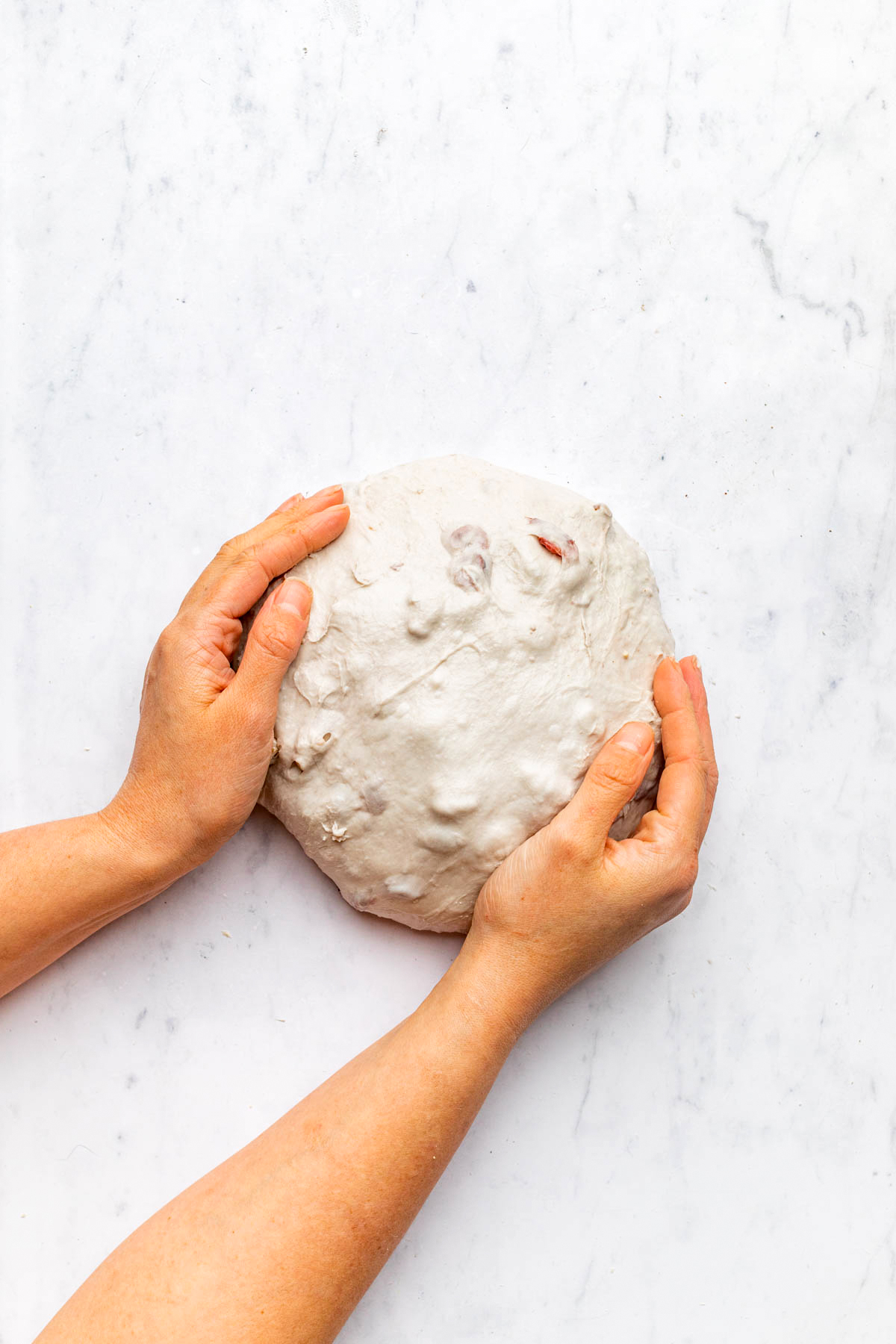
Shape your loaf. 
Turn the loaf over into a prepared banneton.
TOP TIP
We have a post called How To Shape Sourdough Boules if you are new to the concept. When shaping, aim for as much surface tension as possible without tearing the outside of the loaf.
Day 3: Bake The Cranberry Sourdough

Remove your bread from the fridge. 
Gently invert the dough onto parchment paper.
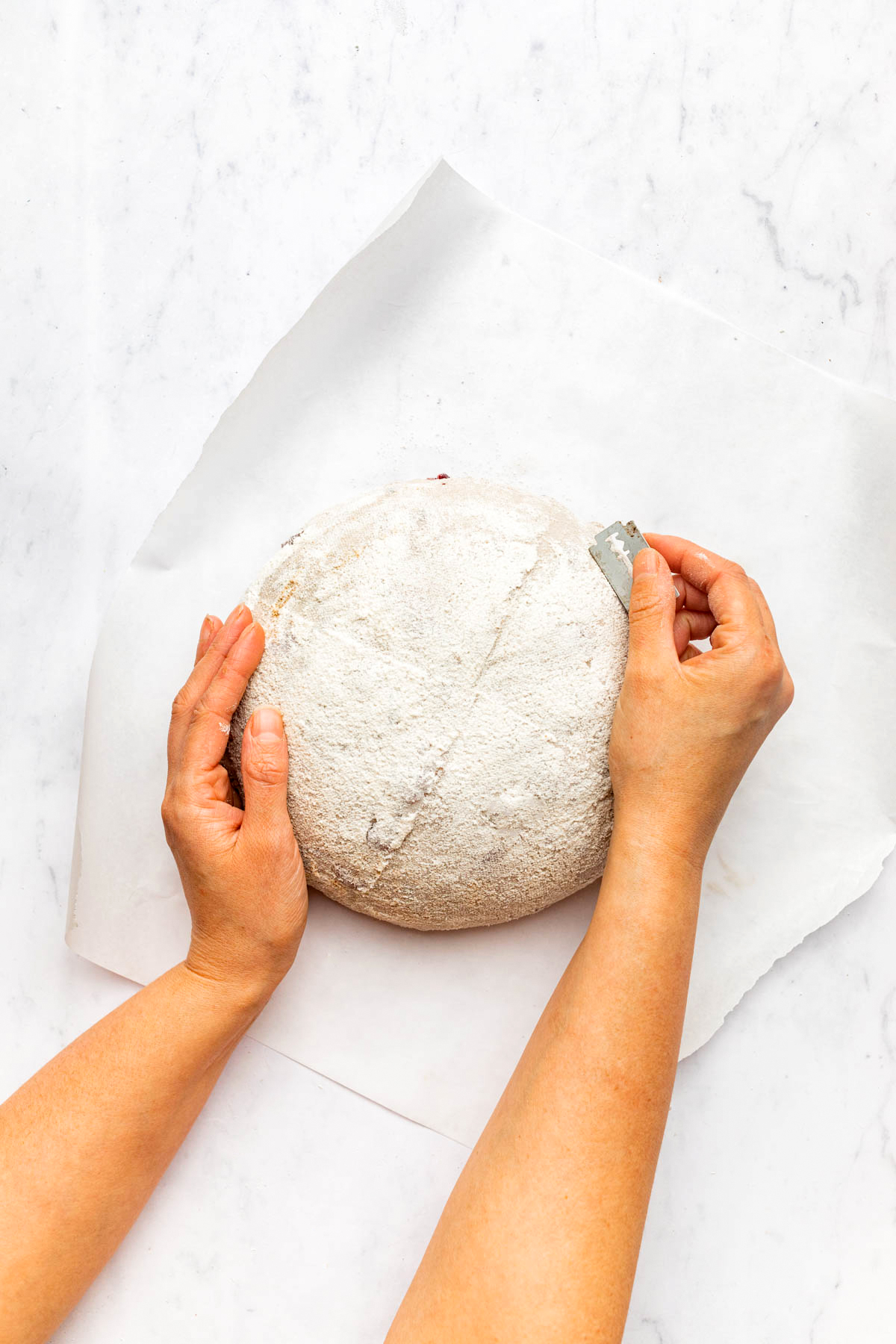
Gently score the bread with a sharp blade or bread lame. 
Carefully lift the dough into a preheated Dutch oven.
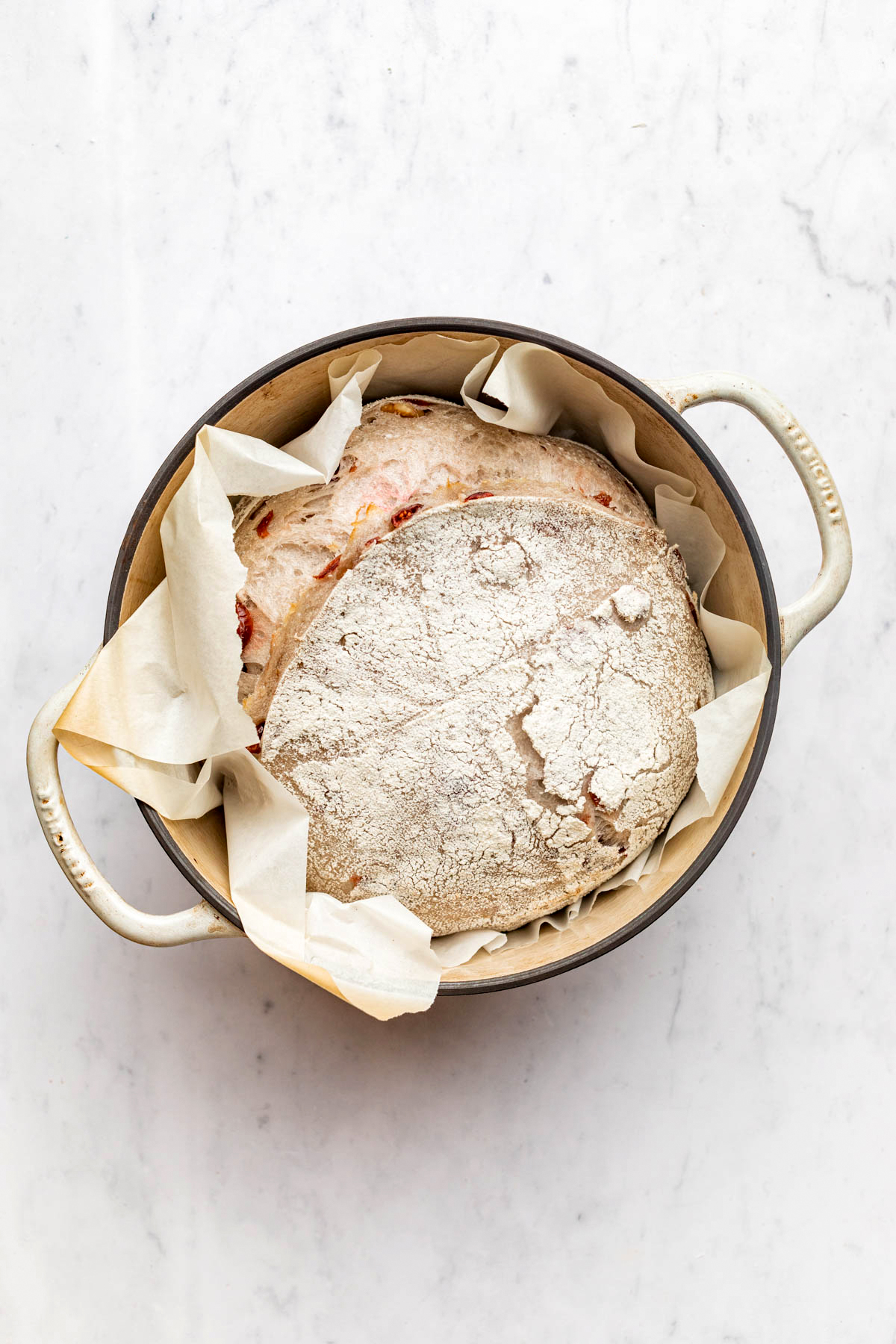
Bake the bread for 20 minutes with the lid on. 
Bake another 22 to 25 minutes with the lid off.
TOP TIP
If heat makes it too difficult to safely remove the final loaf and parchment layer, let the loaf cool directly in the Dutch oven. Don’t risk burning yourself.

Tips & Notes
- If you don’t want to make levain, skip to DAY 2 and use an equal amount of bubbly active sourdough starter.
- You can use a medium-sized mixing bowl lined with a tea towel if you don’t own a banneton. Be sure to dust the tea towel in the bowl generously with flour before placing the dough inside. Flour makes it easier to lift the dough away from the fabric.
- We love rice flour for dusting the inside of our bannetons. You can also use regular flour, or a mix of the two.
- A cast iron Dutch oven works best and can be enamelled or un-enamelled. We prefer cast iron for its even heat distribution and retention.
- Invest in a good pair of oven mitts!
- Walnuts can sometimes react to bread dough and turn an almost purple colour. It can look off-putting but is totally safe to eat.
We have a series of tutorials that may come in handy if you need:
- Sourdough Tools — Our Favourite Essential Sourdough Tools
- Levain — How To Make Sourdough Levain For Sourdough Bread
- Stretch And Folds — How To Stretch And Fold Sourdough
- Shaping — How To Shape Sourdough Boules
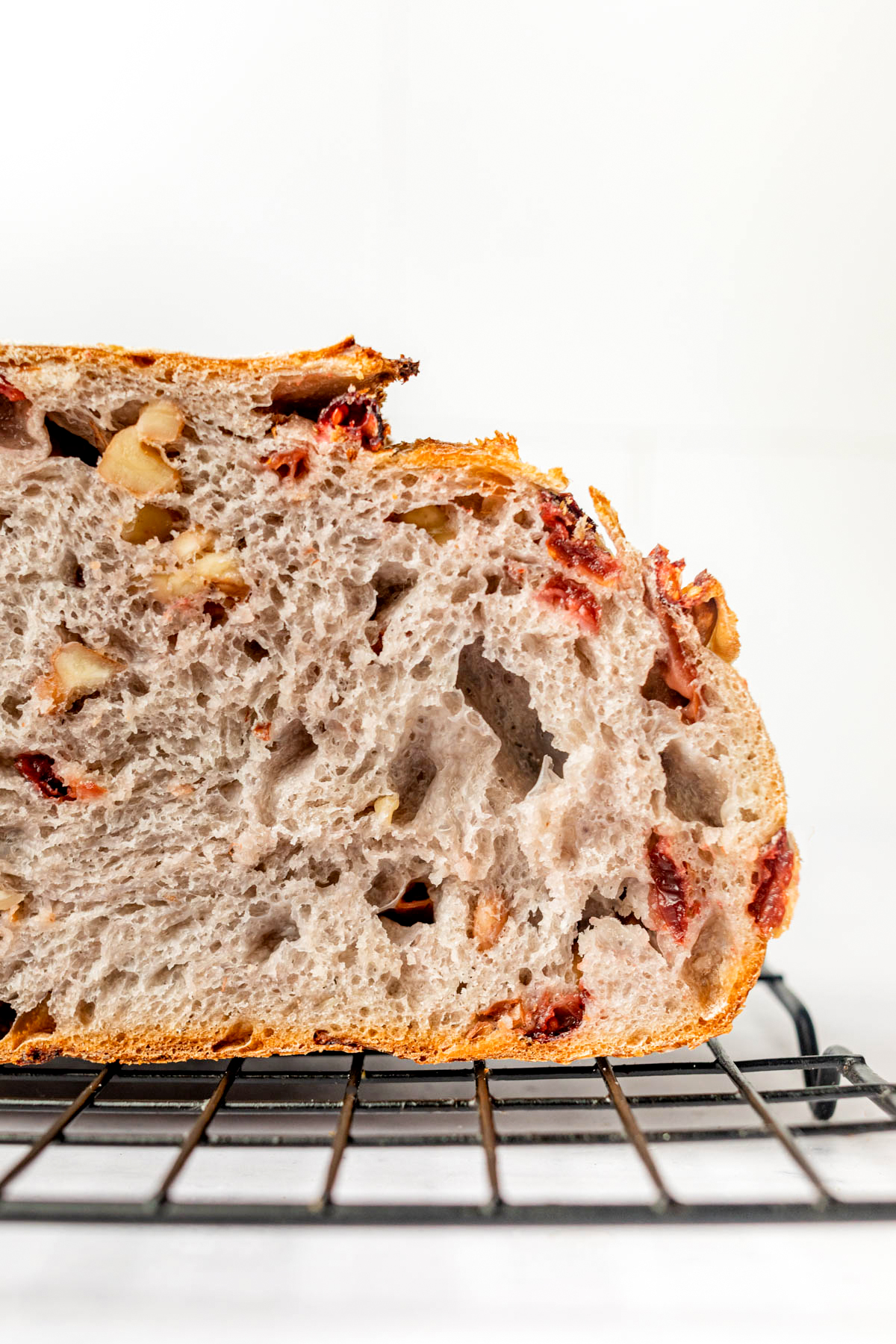
Substitutions
- Levain — Can be substituted with well fed bubbly active starter.
- All-Purpose Flour — You can use bread flour (also called “strong” flour) in place of all-purpose. You can also substitute a portion of the all-purpose flour for light spelt or whole wheat flour. These whole grain options absorb more water which can make for a more dense loaf with a tighter crumb.
- Dried Cranberries —Substitute an equal amount of any dried fruit you like. Raisins, dates, and blueberries are all great options.
- Walnuts — Use raw or (cooled) toasted walnuts. We also love pecans or a mixture of seeds like pumpkin and sunflower.
Storage
- Cranberry sourdough bread is best the day it’s first baked and sliced.
- Alex recommends wrapping your cooled loaf in a tea towel and storing it in a cold oven.
- Once cooled, I like to slice my whole loaf and store it in a large zipper top freezer bag. I keep the bread on the counter for two days, placing the whole bag in the freezer after that (if there’s any left). Frozen slices of sourdough are great for toasting.
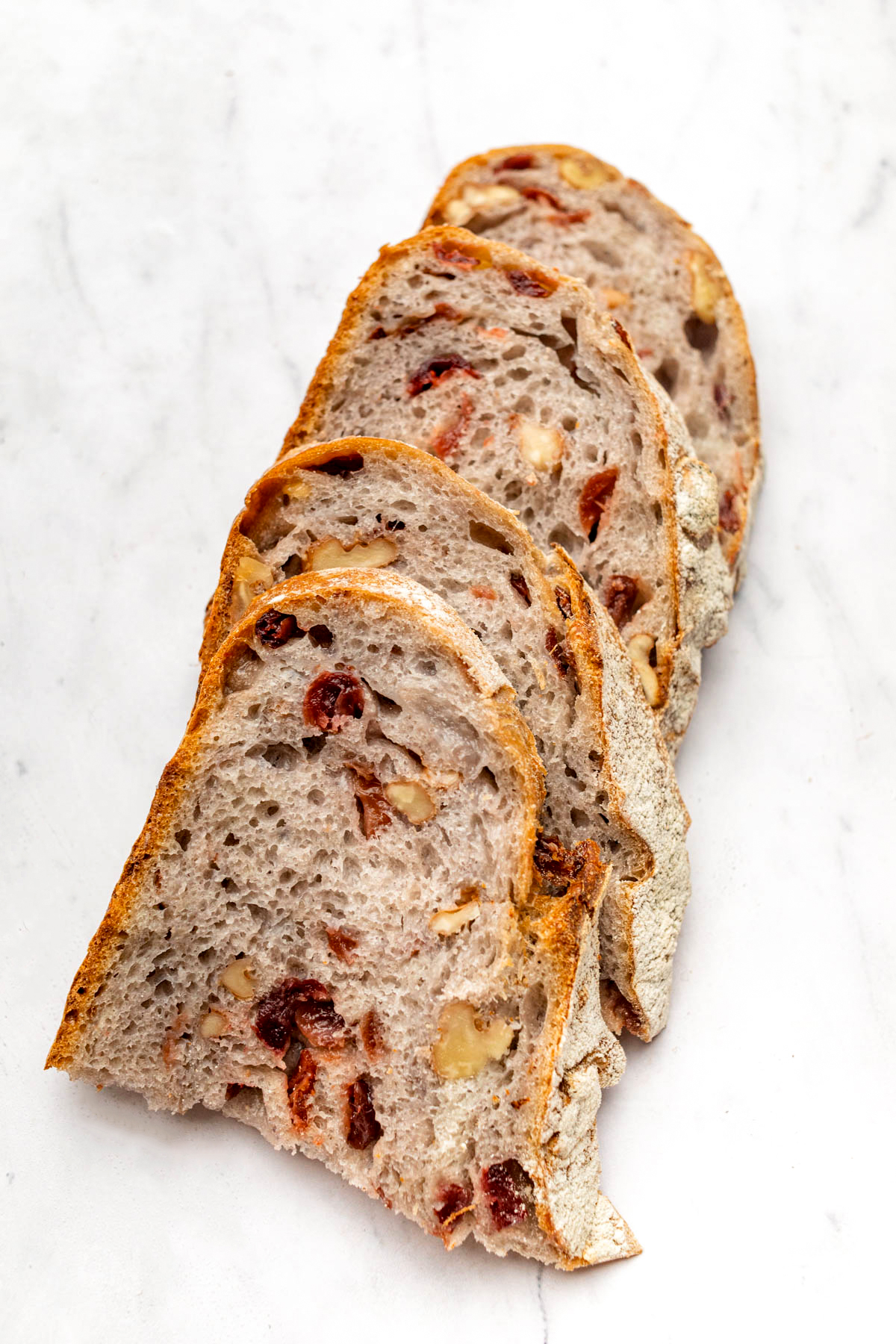
Delicious (& Easy!) Toppings For Cranberry Sourdough Bread
Small-Batch Strawberry Jam With Bay Leaves
Maple Peach Whisky Jam
Rhubarb Compote
Raspberry Rhubarb Jam
Blackberry Chia Jam
If you make this recipe, let us know by tagging @baked_theblog + #bakedtheblog on Instagram! We love to feel like we’re in the kitchen with you.
Recipe
Cranberry Sourdough Bread With Walnuts

Cranberry sourdough bread is a rustic, hearty loaf terrific for toasting or turkey sandwiches! We like walnuts for extra flavour and texture.
Ingredients
- 100 grams levain, made the night before (see instructions)
- 500 grams all-purpose flour
- 375 grams water, room temperature
- 10 grams sea salt
- 100 grams dried sweetened cranberries
- 80 shelled raw walnuts
Instructions
- DAY 1: Make The Levain — Make a leavin the night before you want to start your loaf (visit this post called How To Make Sourdough Levain For Sourdough Bread to learn more about levain). Alternatively, use bubbly active sourdough starter and skip straight to DAY 2.
- DAY 2: Make & Shape The Dough — Combine the all-purpose flour and the water in a large mixing bowl. Add the levain (or an equal amount of bubbly active sourdough starter) to the bowl. Use your hands to mix the ingredients into a rough shaggy dough. Once the dough is mixed, cover the bowl with a tea towel. Let the dough sit at room temperature for 30 minutes to rest.
- While the dough is resting, place the cranberries and walnuts in a second bowl. Cover them with hot tap water, poured about one inch above the top of the berries and nuts. Set aside to soak.
- After the 30 minute resting time has elapsed, sprinkle a bit of salt over the dough. Use your hands to mix the dough around, gradually adding more salt, until the salt is gone and is well distributed throughout the dough.
- Drain the cranberries and walnuts. Add them to the dough, and again, use your hands to mix them in.
- Next do the stretch and folds: Dampen your hands lightly with water. Reach under the dough on the opposite side of the bowl from you. Gently pull the dough up, stretching it as far as you can without tearing it. Once you have stretched it as far as you can, fold the dough over in half, on top of itself, back into the bowl. Turn the bowl a quarter turn and repeat the process on all four quadrants of the bowl. This completes one series of stretch and folds. Do six more series of stretch and folds, one every 30 minutes, for a total of 3 hours (to learn more about stretch and folds visit this post called How To Stretch And Fold Sourdough).
- Shape the dough: Dust a work surface with flour. and lightly dampen your hands. Reach into the bowl and underneath the dough, gently scooping it and coaxing it out onto the work surface. Let the dough rest for 20 minutes. While the dough is resting, prepare a banneton by dusting the inside liberally with flour (we like a mix of wheat flour and rice flour).
- After 20 minutes, shape your loaf. We have a whole post called How To Shape Sourdough Boules if you are new to the concept. When shaping, aim for as much surface tension as possible over the loaf without tearing the outside of it.
- Once shaped, turn the loaf into your prepared banneton with the top of the loaf facing down and the bottom seam facing up. Sprinkle a bit of flour on the exposed dough before covering it gently with a tea towel. Place the loaf in the fridge overnight.
- DAY 3: Bake Your Loaf — Place a Dutch oven, with the lid on, into the oven. Preheat the oven to 500°F (260°C) (if your oven doesn’t reach 500ºF, preheat it at the highest temperature available). Once the oven has come to temperature, continue to preheat the Dutch oven for another 30 minutes.
- Have a large square sheet of parchment paper ready and remove your bread from the fridge. Gently invert the dough onto the parchment paper and lift away the banneton. If your bread is sticking, give it a few occasional gentle shakes until it releases. Gently score the bread with a sharp blade or bread lame in any pattern you like. Using oven mitts, carefully remove the Dutch oven from the oven. Remove the lid, then carefully lift the dough into the hot pot using the parchment paper as “handles”. Again, using oven mitts, carefully place the lid back on the Dutch oven, then put the whole pot back into the heated oven. Reduce the oven temperature to 450°F (230°C) and bake the bread for 20 minutes. Wearing oven mitts, remove the pot from the oven. Carefully remove the lid (be careful of steam) and bake the loaf for another 22 to 25 minutes with the lid off.
- Remove the pot from the oven. Carefully lift the loaf out of the pot using the edges of the parchment paper and set it on a wire cooling rack. Remove the parchment paper once it’s cool enough to do so, then leave the loaf on the rack to cool completely before slicing, about 5 to 6 hours.
Notes
Tips & Notes
- If you don't want to make levain, skip to DAY 2 and use an equal amount of bubbly active sourdough starter.
- You can use a medium-sized mixing bowl lined with a tea towel if you don't own a banneton. Be sure to dust the tea towel in the bowl generously with flour before placing the dough inside. Flour makes it easier to lift the dough away from the fabric.
- We love rice flour for dusting the inside of our bannetons. You can also use regular flour, or a mix of the two.
- A cast iron Dutch oven works best and can be enamelled or un-enamelled. We prefer cast iron for its even heat distribution and retention.
- Invest in a good pair of oven mitts!
- Walnuts can sometimes react to bread dough and turn an almost purple colour. It can look off-putting but is totally safe to eat.
We have a series of tutorials that may come in handy if you need:
- Sourdough Tools — Our Favourite Essential Sourdough Tools
- Levain — How To Make Sourdough Levain For Sourdough Bread
- Stretch And Folds — How To Stretch And Fold Sourdough
- Shaping — How To Shape Sourdough Boules
Substitutions
- Levain — Can be substituted with well fed bubbly active starter.
- All-Purpose Flour — You can use bread flour (also called "strong" flour) in place of all-purpose. You can also substitute a portion of the all-purpose flour for light spelt or whole wheat flour. These whole grain options absorb more water which can make for a more dense loaf with a tighter crumb.
- Dried Cranberries —Substitute an equal amount of any dried fruit you like. Raisins, dates, and blueberries are all great options.
- Walnuts — Use raw or (cooled) toasted walnuts. We also love pecans or a mixture of seeds like pumpkin and sunflower.
Storage
- Cranberry sourdough bread is best the day it's first baked and sliced.
- Alex recommends wrapping your cooled loaf in a tea towel and storing it in a cold oven.
- Once cooled, I like to slice my whole loaf and store it in a large zipper top freezer bag. I keep the bread on the counter for two days, placing the whole bag in the freezer after that (if there's any left). Frozen slices of sourdough are great for toasting.
Nutrition Information:
Yield:
8Serving Size:
1Amount Per Serving: Calories: 235Total Fat: 1gSaturated Fat: 0gTrans Fat: 0gUnsaturated Fat: 0gCholesterol: 0mgSodium: 488mgCarbohydrates: 49gFiber: 2gSugar: 1gProtein: 7g
This is an approximation of the nutrition offered in this recipe, and is created using a nutrition calculator.
The post Cranberry Sourdough Bread With Walnuts appeared first on Baked.